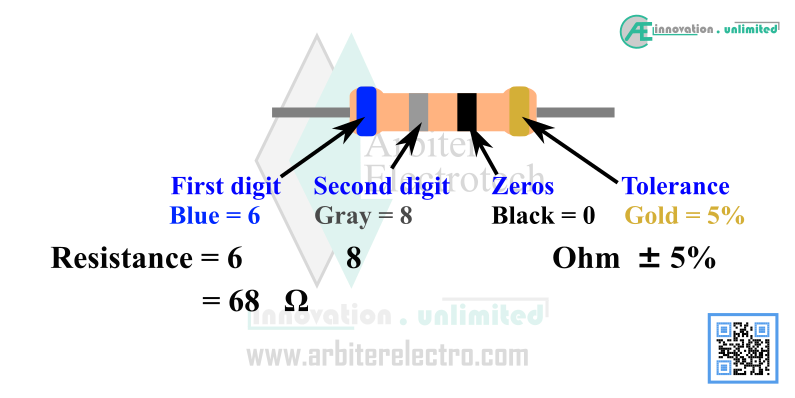H. Rahman2023-07-10T19:53:56+06:00
Introduction
Resistors are electronic components that introduces some non-zero resistance in the circuit. The value of the resistance can be checked using a multimeter. But there can be situations where using a multimeter may not be an option for whatever reason. Like any other electronics component, the value of the resistors are printed on the body of the resistor. The interesting point is how the resistance is printed using not using digits but colors. These colors are known as Color Code. Knowing how to read resistor color code is a mandatory skill for anyone in the field of electronics.
The resistors are small and so any writing or marking on them has to be even smaller to fit the small space. But it is not always possible to fit values in small space especially if the value is a large one. For example, we may easily fit the number 1000 on a resistor but it would be difficult to fit the number 18000000 on such small space. And even if the writings fit the space, it would be too small to see using bare eyes. It is possible to make the writing very small but then a magnifying glass will be needed to read the values. For these reasons the resistance value is printed using color code.
Basics of Color Codes
Color codes are read in a certain way. When we read a book, we always read it left to right (unless you are reading arabic). That means we start reading from the left side and read toward the right side. Color code is read in a similar way. Color code employs multiple colors to denote different numbers. Starting from 0 to 9, each number has a single color assigned for it.
Most resistors are manufactured in an axial/cylindrical footprint. The colors are printed as strips around the entire cylindrical surface. Each color strip is called a Band. A resistor can have anything from 4 to 6 bands on it. The bands are placed side by side. The position of the band also holds a meaning. For example, the position of the band can signify a single numerical value, tolerance, multiplier etc. By placing the bands of proper color in a defined way, any positive number from 1 to virtually anything can be printed on the small surface of the resistor.


Before starting to read the color code, we need to know the number of bands on the resistor. The number of bands must be counted beforehand as color code differs with the number of bands. Resistor can have 4,5 or 6 bands. Each of the bands occupy a specific position and each position has a specific meaning. For beginners, it is easier to start by reading the 4 band resistors. As 5 and 6 bands are a little more advanced, we leave them for later.
Tolerance
The tolerance band defines the percentage error between the actual resistance and the printed resistance. That means, there will always be a small difference between the printed resistance and the actual resistance of the resistor. The reason is simple. You already know that every consumer product in our everyday life are made in factories. In factories, everything is produced in a huge quantity at a time. This allows manufacturers to reduce the price of the product and at the same time produce large quantity of products at a time for shipping and storage. When large quantity of something is produced, it is very likely that individual pieces of the products may be manufactured with a little deviation from targeted quality. That means that two resistors manufactured at the same time will have small difference between them. It is possible to avoid this difference by putting extra care during the manufacturing process. But extra care means more money will have to be spent during manufacturing and this causes increase in the product’s cost. Some people may buy the higher priced product because they need or care about quality but most people want cheaper price. Besides there are times where it is necessary to use better quality product. This is the reason why manufacturers produce the same product with many different qualities and each quality has a different price. The manufacturers make the best use of the saying “You get what you pay for”.
Take a look at tolerance table. It shows the available tolerance of resistors. There are 7 different tolerance colors. That means the same resistor can have 7 different qualities and therefore 7 different price. Note that as tolerance gets smaller, the quality or precision of the resistor gets better and price gets higher.
Reading a 4 Band Resistor
The following steps shows the way to read a 4 band resistor. Use the steps precisely to read the resistor accurately. The steps are followed by a figure to show the entire process.
Steps:
1. To read a 4 band resistor, first, locate the tolerance band. Keep the tolerance band on the right side. (Note – Keep gold & silver on the right side. Also keep the wider gap on the right side)
2. Now start reading from the left. Assume we are reading a 4 band resistor and the colors are Black Red Orange Gold. Refer to the appropriate table.
3. The first two bands are digits. Refer to the digit table. From the table, Black = 1, Red = 2.
4. The third digit band is number of zeros. From the digit table, Red = 2. That means there are two zeros.
5. Fourth band is tolerance. From tolerance table, gold = 5. That means tolerance is 5%.
6. Combining it altogether, we get 4 7 00 ± 5%. The resistance is therefore 4700 Ohm with 5% error.
Note: A 4 band resistor will never have tolerance less than 5%.

Resistor color code shows the intended value of the resistor. The actual value of the resistor is within 5% of the printed value. Therefore, the printed value of the resistor is read as 4.7K ± 5%. This means the value of resistor is anywhere from 1K+5% to 1K−5%. 5% of 1K or 1000 is 50. The actual resistance of the resistor will be between 1000-50 = 950 and 1000 + 50 = 1050. To know the actual resistance, a multimeter must be used.
Example - 1

Example - 2

Example - 3

Example - 4

Reading a Precision Resistor
Now we look at precision resistors. Precision resistors always have either 5 or 6 bands. For 5 & 6 bands, first 3 bands are numbers and the fourth band is the number of zeros. The fifth band is the tolerance and the sixth band is temperature coefficient. Precision resistors are read in the following manner.
Steps:
1. First, locate the tolerance band. Keep the tolerance band on the right side. (Note – Keep gold & silver colors on the right side. Also keep the wider gap on the right side)
2. Now start reading from the left. We are reading a 5 band resistor and the colors are Blue Grey Black Orange & Brown. Refer to the appropriate table.
3. The first three bands are digits. Refer to the digit table. From the table, Blue = 6, Grey = 6, Black = 0.
4. Fourth digit band is number of zeros. From the digit table, Orange = 2. That means there are two zeros.
5. Fifth band is tolerance. From tolerance table, Brown = 1. That means tolerance is 1%.
6. Combining it altogether, we get 6 60 00 ± 1%. The resistance is therefore 680000 Ohm with 1% tolerance/error.
Take a look at tolerance table. It shows the available tolerance of resistors. There are 7 different tolerance colors. That means the same resistor can have 7 different qualities and therefore 7 different price. Note that as tolerance gets smaller, the quality or precision of the resistor gets better and price gets higher.

Resistor color code is the basic staple for electronics. Anyone who is even slightly related to the field of electronics will need to know the method of reading the color code. It is helpful to keep the color code table handy for emergency. The reader can download a PDF of the color code tables along with the color code reading method below.
This file is free to distribute in its original unmodified form.


Leave a Reply